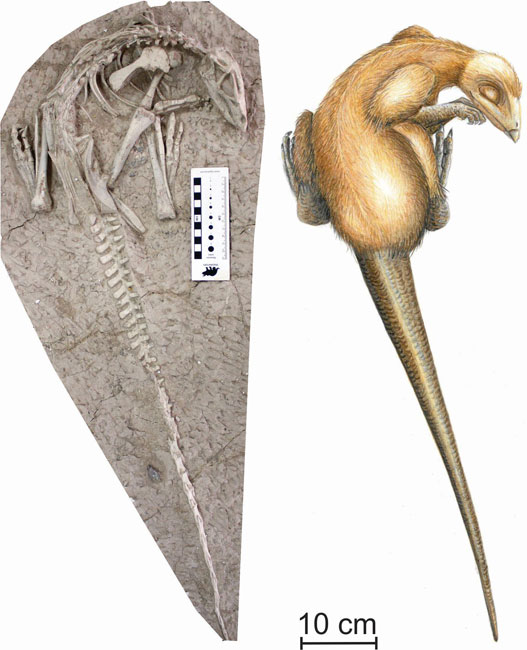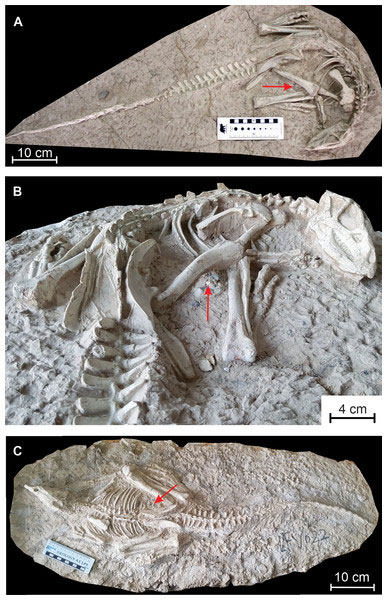Changmiania liaoningensis A New Basal Ornithopod from Liaoning Province
A new species of basal ornithopod dinosaur has been named and described from Liaoning Province in north-eastern China. The dinosaur has been named Changmiania liaoningensis which translates from the Chinese as “eternal sleeper from Liaoning”. The researchers which include Pascal Godefroit of the Royal Belgian Institute of Natural Sciences and Paul-Emile Dieudonné (Universidad Nacional de Río Negro, Argentina), in collaboration with colleagues from Jilin University and Shenyang Normal University (China), postulate that Changmiania lived in burrows.
The Holotype of Changmiania liaoningensis (PMOL AD00114) and a Life Reconstruction

Picture credit: Carine Ciselet
From the Lujiatun Beds of the Yixian Formation
The pair of beautifully preserved fossils, like so many vertebrate fossils from this part of the world were acquired from farmers. Many locals supplement their incomes by finding and excavating specimens. Whilst welcoming the opportunity to be able to study the material, palaeontologists are often frustrated by the lack of information available to them pertaining to the fossil’s location and how it was preserved (taphonomy). However, it is thought that the fossils herald from the Lujiatun Beds (Yixian Formation) of western Liaoning Province.
These three-dimensional fossils were formed when these dinosaurs were entombed in pyroclastic material created by a volcanic eruption. Numerous dinosaurs are known from the Lujiatun Beds including the dromaeosaurid Graciliraptor (G. lujiatunensis), the troodontid Mei long, the small tyrannosauroid Dilong paradoxus along with psittacosaurs, neoceratopsians and the ornithopod Jeholosaurus (J. shanyuensis).
Changmiania liaoningensis
Scientists have been able to accurately date the volcanic ash layer to approximately 123 million years ago, which means this diverse dinosaur biota lived during the early Aptian faunal stage of the Early Cretaceous. The hot, volcanic debris that covered these two dinosaurs may have perfectly preserved most of the skeleton but any evidence of an integumentary covering such as feathers was destroyed as these animals met their fate whilst fast asleep in their burrows. The resting dinosaurs having been caught up and consumed in a violent pyroclastic flow is the scenario tentatively proposed by the research team in the scientific paper published in PeerJ.
The Two Fossils of Changmiania liaoningensis

Picture credit: Yang et al (PeerJ)
A Basal Ornithopod
The little dinosaur measured approximately 1.2 metres long, the tail representing fifty percent of the animal’s total body length. The extremely short neck, consisting of just six cervical vertebrae, the robust forelimbs and stocky shoulder blades suggest that this dinosaur might have dug burrows. This idea is supported by the position of the fossil specimens and the morphology of the front of the skull, which may have assisted with shovelling dirt aside. The long hindlimbs and tail indicate that Changmiania was a fast runner, able to avoid trouble whilst away from its underground den.
This is not the first time fossorial behaviour has been inferred for a dinosaur. For example, in 2007 Everything Dinosaur wrote a short post about another potential burrowing ornithischian, another basal ornithopod that was named Oryctodromeus cubicularis, remains of which come from the sandstones of the Blackleaf Formation of Montana (USA): A Burrowing Dinosaur from Montana.
Changmiania lived at least 10 million years earlier than O. cubicularis. A phylogenetic analysis places Changmiania liaoningensis as the most basal ornithopod dinosaur known to science.
The scientific paper: “A new basal ornithopod dinosaur from the Lower Cretaceous of China” by Yuqing Yang, Wenhao Wu, Paul-Emile Dieudonné and Pascal Godefroit published in PeerJ.
Visit the Everything Dinosaur website: Everything Dinosaur.






Leave A Comment